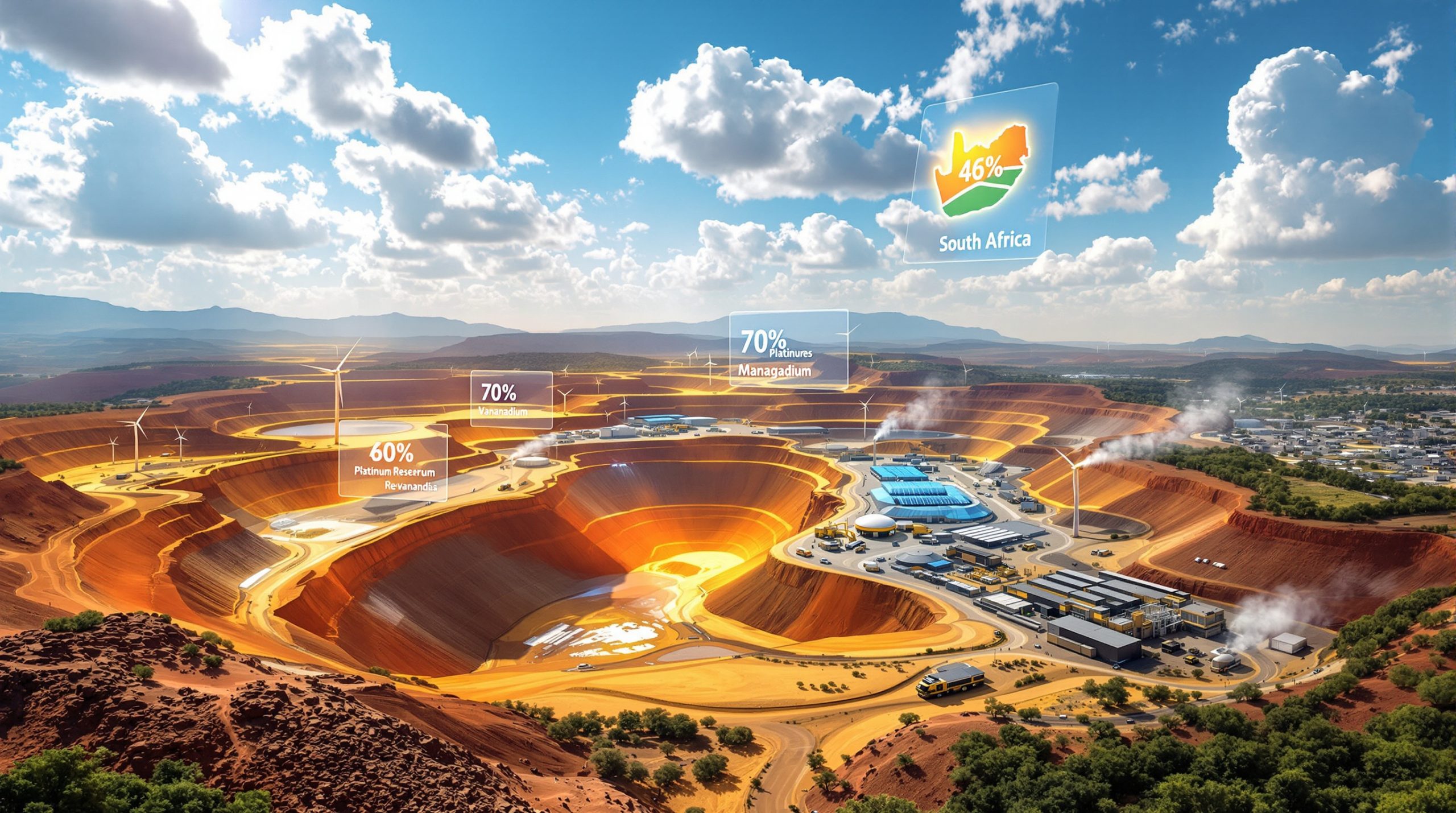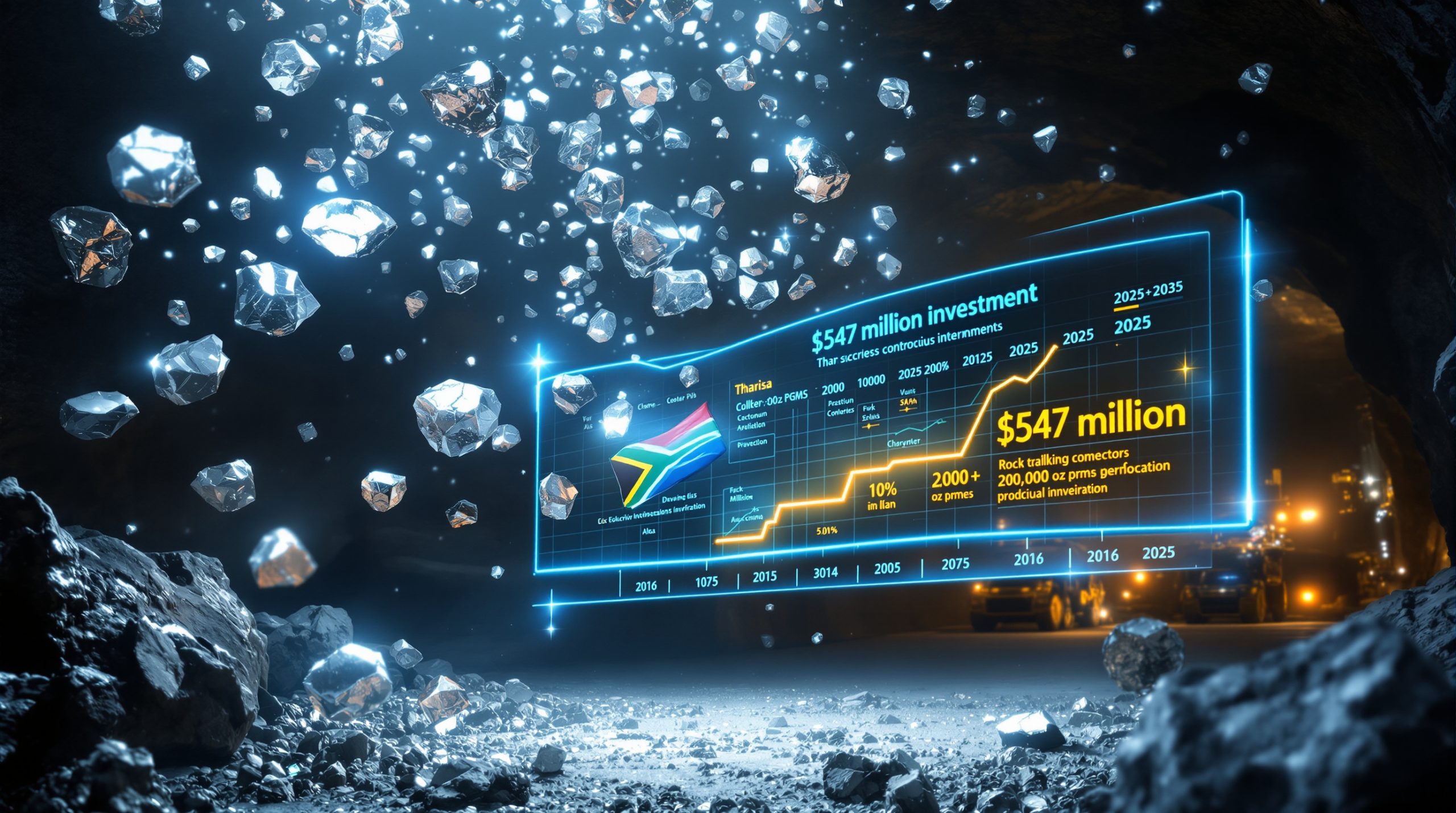Australia's journey toward becoming an Australia critical minerals superpower requires a comprehensive transformation that extends far beyond simple resource extraction. The nation must demonstrate substantial geological endowments, sophisticated processing infrastructure, and strategic international alliances that secure its position in global supply chains.
Understanding Critical Minerals Superpower Status
Achieving critical minerals superpower status requires nations to demonstrate three fundamental capabilities that extend far beyond simple resource extraction. These countries must possess substantial geological endowments, sophisticated processing infrastructure, and strategic international alliances that secure their position in global supply chains.
The framework for superpower status encompasses several measurable criteria. Nations must control significant market shares across multiple critical mineral categories while maintaining stable political environments that attract sustained international investment. Furthermore, these countries develop comprehensive downstream processing capabilities rather than remaining dependent on raw material exports.
Australia's Ambassador to the United States Kevin Rudd articulated this vision during an August 2025 forum, stating that Australia possesses the potential to become a great power in critical minerals and rare earths. He emphasised three core strengths: the world's largest mining industry and mining companies, vast geological resources spanning most of the periodic table, and growing processing capabilities.
Essential characteristics of critical minerals superpowers include:
- Dominant market positions in multiple strategic mineral categories
- Advanced processing facilities creating value-added exports
- Political stability encouraging long-term investment commitments
- Strategic partnerships securing preferential supply agreements
- Technology leadership in extraction and processing methods
Australia's Exceptional Geological Foundation
Australia's continental landmass represents one of Earth's most diverse mineral provinces, with extensive geological formations containing critical materials essential for modern technology and energy transition. The country's geological advantages stem from ancient rock formations and varied mineralisation processes occurring over billions of years.
Current geological surveys indicate that approximately 80 percent of Australia's continental area remains underexplored using modern techniques. This vast unexplored territory, combined with already proven reserves, creates unprecedented potential for discovering additional critical mineral deposits across multiple commodity categories.
Lithium Production Leadership
Australia currently dominates global lithium production, contributing approximately 49 percent of worldwide supply through hard rock spodumene operations concentrated in Western Australia. This production advantage stems from large-scale, mechanised mining operations that achieve significant economies of scale.
The Australia lithium industry tax breaks demonstrate government commitment to maintaining this leadership position. Major lithium operations show Australia's production capabilities through facilities like the Greenbushes Mine, operating as the world's largest hard rock lithium facility.
Moreover, Mount Marion represents another significant spodumene concentrate producer. The Pilbara region hosts multiple emerging projects that will expand national production capacity substantially. These operations benefit from established infrastructure, skilled workforce availability, and proximity to export facilities.
Rare Earth Elements Processing Capabilities
The Lynas rare earths processing facility in Kalgoorlie, Western Australia, represents the largest rare earth processing plant outside China. This integrated facility processes ore from the Mount Weld mine to produce mixed rare earth carbonate, demonstrating Australia's capability to complete the entire value chain from extraction through processing.
Mount Weld contains the largest rare earth deposit outside China, providing strategic importance for global supply chain diversification. The integrated approach from mining through processing demonstrates technical capabilities that challenge Chinese market dominance in rare earth elements.
Production highlights include:
- Mixed rare earth carbonate processing capacity exceeding Chinese alternatives
- Strategic emphasis on heavy rare earth elements with higher value applications
- Integrated supply chain reducing dependency on foreign processing
- Technology partnerships advancing processing efficiency
Copper Resources Supporting Electrification
Australia's copper reserves position the nation to capitalise on growing demand from global electrification trends. The copper production outlook indicates substantial demand increases as renewable energy systems, electric vehicles, and digital infrastructure require significantly more copper than traditional applications.
| Project | Location | Strategic Significance |
|---|---|---|
| SA Copper | South Australia | BHP's flagship copper development |
| Copper Resolution | Arizona (BHP-Rio Joint Venture) | International expansion initiative |
| Olympic Dam | South Australia | Integrated copper-uranium operation |
These projects represent billions of dollars in potential investment and thousands of employment opportunities. The SA Copper project alone could transform South Australia into a major copper producing region, whilst international partnerships like Copper Resolution demonstrate Australian companies' global reach.
Government Policy Framework Driving Transformation
The Australian government has implemented comprehensive policy frameworks designed to transform the nation's role from raw material supplier to integrated critical minerals processor and strategic partner. These policies create incentives for domestic processing whilst strengthening international partnerships.
Critical Minerals Strategic Reserve Development
Australia's planned critical minerals strategic reserve, launching operationally by late 2026, represents a fundamental shift from traditional stockpiling toward active supply chain participation. The A$1.2 billion initiative focuses on production agreements rather than passive inventory accumulation.
This strategic approach creates multiple benefits for Australian industry. The reserve supports domestic processing development whilst reducing global dependency on single-source suppliers. International partners gain supply security through long-term agreements, strengthening alliance relationships through resource cooperation.
Reserve operational objectives include:
- Securing multi-year supply agreements with strategic international partners
- Supporting domestic processing facility development through guaranteed offtake
- Reducing global supply chain vulnerabilities through diversification
- Strengthening alliance relationships through resource security cooperation
- Creating price stability mechanisms for critical mineral markets
Investment Incentives and Strategic Asset Protection
New policy frameworks balance international capital attraction with strategic asset protection through enhanced screening processes. These policies encourage foreign investment in processing facilities whilst maintaining Australian control over strategic mineral resources.
Production tax credits support domestic critical mineral processing development, making Australian facilities more competitive against established international operations. Infrastructure development support assists companies in building processing capabilities, whilst research and development incentives encourage technological advancement.
Enhanced foreign investment review processes ensure strategic mineral assets remain under appropriate oversight. These mechanisms protect national interests whilst maintaining Australia's reputation as an attractive investment destination for legitimate international partners.
Strategic International Partnership Development
Australia's path toward critical minerals superpower status depends heavily on strategic alliances that create integrated supply chains spanning from extraction through end-use manufacturing. These partnerships provide market access whilst securing technology transfer and investment capital.
United States Alliance and Defence Integration
The deepening Australia-US partnership extends beyond traditional defence cooperation into comprehensive critical minerals security arrangements. Recent high-level meetings between Australian mining executives and US government officials demonstrate the strategic importance of these relationships.
BHP CEO Mike Henry met with President Donald Trump and Secretary of the Interior Doug Burgum in August 2025, discussing the BHP-Rio Tinto joint venture Copper Resolution project in Arizona. Henry emphasised copper's essential role in modern infrastructure, stating that "copper serves as a critical component in powerlines, smartphones, medical equipment, cars, and data centres."
The US Government has actively pursued critical minerals energy transition supply chain development, including improved access to rare earth elements. This policy alignment creates opportunities for Australian companies to participate in US supply chains whilst supporting American strategic objectives.
Partnership elements encompass:
- Joint venture mining projects expanding bilateral cooperation
- Technology sharing agreements for processing innovations
- Defence supply chain integration supporting alliance objectives
- Clean energy transition collaboration advancing mutual goals
- Investment frameworks encouraging cross-border capital flows
Indo-Pacific Regional Cooperation Framework
Australia leverages its strategic geographic position to serve growing Asian markets whilst maintaining Western alliance commitments. This balanced approach creates opportunities for expanded market access without compromising strategic relationships.
Regional cooperation initiatives focus on sustainable development and technology transfer. Japanese and South Korean partnerships emphasise battery supply chain development, whilst Indian cooperation targets emerging market development. Southeast Asian partnerships explore regional processing hub development opportunities.
Nova Minerals exemplifies this international cooperation approach. Headquartered in Melbourne with operations in Alaska, the company prepared briefings for the Trump-Albanese meeting regarding its Estelle mine project. The project has received US Government funding and represents potential integration into US antimony supply chains.
Processing Capabilities Enhancing Strategic Value
Raw material exports alone cannot sustain superpower status in critical minerals. Value-added processing creates economic multipliers whilst providing strategic leverage in global supply chains. Australia's development of processing capabilities represents a fundamental shift in industry strategy.
Midstream Processing Infrastructure Development
The critical raw materials facility development evaluates common-use facility opportunities in Western Australia to support midstream processing, refining, and advanced material manufacturing. This shared infrastructure approach reduces individual company capital requirements whilst creating economies of scale.
Shared processing facilities provide multiple advantages for participating companies. Reduced capital requirements enable smaller companies to access advanced processing technologies, whilst shared technical expertise and operational costs improve overall competitiveness. These facilities achieve economies of scale that individual operations cannot attain independently.
Processing infrastructure advantages include:
- Reduced capital requirements enabling broader industry participation
- Shared technical expertise accelerating technology adoption
- Operational cost efficiencies improving global competitiveness
- Enhanced processing capabilities supporting premium product development
- Technology development platforms advancing industry innovation
Technology and Innovation Leadership
Australia's mining equipment, technology, and services (METS) sector provides competitive advantages in extraction and processing efficiency. These capabilities support both domestic operations and international technology export opportunities.
Advanced extraction technologies reduce environmental impact whilst improving operational efficiency. Automation and remote operations capabilities enhance safety whilst boosting productivity in challenging environments. Metallurgical innovations increase recovery rates, maximising resource utilisation from existing deposits.
Hayley Channer, Director of the Economic Security Program at the United States Studies Centre, emphasised the importance of technological collaboration. She noted that "combining American scientists with Australian metallurgists and geologists could accelerate development timelines, with co-investment in processing infrastructure speeding implementation."
Sustainable processing methods meet increasingly stringent environmental, social, and governance (ESG) requirements demanded by international markets. These capabilities provide competitive advantages as global standards continue evolving toward sustainability requirements.
Overcoming Strategic Challenges
Despite significant advantages, Australia faces substantial obstacles in achieving true critical minerals superpower status. These challenges require coordinated responses involving government policy, industry investment, and international cooperation initiatives.
Infrastructure and Logistics Constraints
Remote mine locations and processing facility requirements demand significant infrastructure investment across multiple sectors. Port facility expansion supports increased export volumes, whilst rail and road connections enable efficient transportation from remote mining areas to processing and export facilities.
Power supply requirements for energy-intensive processing operations present particular challenges in remote locations. Water resources for mining and processing activities require careful management, especially in arid regions where many deposits are located.
Kevin Rudd identified pricing mechanisms as a critical missing component in current arrangements. Developing transparent, stable pricing frameworks remains essential for long-term partnership success and market development.
Infrastructure development priorities include:
- Port capacity expansion accommodating increased export volumes
- Transportation networks connecting remote deposits to processing facilities
- Energy infrastructure supporting processing operations
- Water resource management systems ensuring sustainable operations
- Communications infrastructure enabling remote operations management
Workforce Development and Skills Requirements
Rapid industry expansion creates workforce pressures across technical and operational roles. Specialised processing technicians are required for advanced facility operations, whilst research and development personnel support innovation programmes.
Project management expertise becomes increasingly important as development scales expand. Indigenous employment opportunities in remote mining regions provide social benefits whilst addressing workforce needs. Training programmes must balance immediate operational requirements with long-term skill development objectives.
International collaboration offers solutions to skills shortages. Partnerships with American scientists and technologists could accelerate capability development whilst creating knowledge transfer opportunities that benefit both nations.
Major Mining Companies Leading Transformation
Australia's largest mining corporations possess the scale, expertise, and international reach necessary to execute superpower strategies across multiple commodity sectors. These companies drive industry transformation through strategic investments and partnership development.
BHP's Integrated Global Strategy
As the world's largest copper producer, BHP leverages its scale to secure strategic partnerships whilst developing integrated supply chains spanning multiple continents. The company's strategic initiatives demonstrate comprehensive approaches to critical minerals development.
BHP's Copper Resolution project with Rio Tinto in Arizona represents international expansion supporting US supply chain objectives. The SA Copper development in South Australia could transform domestic production capacity whilst creating thousands of employment opportunities.
Mike Henry emphasised the strategic importance of copper production, noting that "growing demand requires increased mining activity to build future infrastructure." This vision aligns with global electrification trends requiring substantially more copper than traditional applications.
BHP strategic initiatives encompass:
- Copper Resolution project advancing US-Australia cooperation
- SA Copper development expanding domestic production capacity
- Technology partnerships supporting sustainable extraction methods
- Long-term supply agreements providing market stability
- Integration across value chains maximising strategic leverage
Rio Tinto's Diversification Approach
Rio Tinto's expansion beyond iron ore into critical minerals demonstrates industry-wide strategic shifts toward higher-value commodities. The company's diversification strategy targets growing markets whilst leveraging existing operational expertise.
Simon Trott, Rio Tinto's CEO, participated in August 2025 meetings with President Trump alongside BHP leadership, demonstrating coordinated industry approaches to international partnership development. These meetings discussed the Copper Resolution joint venture and broader strategic cooperation initiatives.
Lithium development projects across multiple jurisdictions provide portfolio diversification whilst accessing growing battery materials markets. Rare earth exploration partnerships expand the company's critical minerals exposure beyond copper and lithium.
Battery materials focus aligns with energy transition market trends requiring substantially increased production of specialised materials. Sustainable mining practices address ESG standards demanded by international customers and financial markets.
How Can Australia Measure Superpower Success?
Success in achieving critical minerals superpower status requires measurable progress across production, processing, and partnership dimensions. These metrics create accountability whilst demonstrating progress toward strategic objectives.
Production and Market Leadership Targets
Maintaining and expanding market leadership positions across multiple commodities demonstrates superpower capabilities. Current market positions provide foundations for expanded influence through increased production and processing capabilities.
| Mineral | Current Global Position | Strategic Expansion Opportunities |
|---|---|---|
| Lithium | 49% of global production | Maintain leadership through project pipeline |
| Rare Earths | Largest non-Chinese producer | Expand processing capacity and market share |
| Copper | Major global producer | Increase production through SA Copper development |
| Antimony | Emerging producer via Alaska | Develop integrated US supply chain participation |
These market positions create strategic leverage in international negotiations whilst providing economic benefits through value-added exports. Expanded production capabilities support domestic processing development whilst serving international market demand.
Value-Added Processing Growth Metrics
Transformation from raw material exporter to processed goods supplier creates economic multipliers whilst enhancing strategic influence. Processing capability development represents fundamental shifts in industry structure and international positioning.
Downstream processing facilities for battery-grade materials serve growing electric vehicle and energy storage markets. Advanced manufacturing partnerships with technology companies create integrated supply chains spanning from mining through end-use applications.
Research and development hubs support next-generation applications whilst maintaining technological leadership. Export diversification beyond traditional commodity markets reduces dependency on single-market relationships whilst creating multiple revenue streams.
Processing development priorities include:
- Battery-grade material production capabilities
- Advanced manufacturing partnership development
- Research and development facility establishment
- Export market diversification initiatives
- Technology leadership in processing innovations
Implementation Timeline and Strategic Milestones
Australia's transformation into a critical minerals superpower follows a structured timeline with specific milestones marking progress toward strategic objectives. These phases create accountability whilst ensuring coordinated development across government and industry initiatives.
Foundation Phase: 2025-2027
The foundation phase emphasises policy implementation and infrastructure development supporting expanded processing capabilities. The Critical Minerals Strategic Reserve becomes operational, whilst major processing facility construction begins across multiple locations.
International partnership agreements finalised during this period create frameworks for long-term cooperation. The October 2025 Trump-Albanese meeting represents a pivotal moment for US-Australia critical minerals cooperation, potentially establishing precedents for future partnership development.
Major project approvals and construction commencement mark tangible progress toward processing capability development. Investment commitments from international partners demonstrate confidence in Australia's strategic direction and policy stability.
Expansion Phase: 2028-2030
Significant processing capacity comes online during the expansion phase, transforming Australia's role from raw material supplier to integrated processor. Market share consolidation across key minerals demonstrates strategic progress whilst creating economic benefits.
Technology leadership establishment through successful facility operations and innovation programmes enhances international competitiveness. Partnership agreements mature into operational relationships delivering mutual benefits for participating nations and companies.
Processing facility performance metrics demonstrate technical capabilities whilst establishing Australia as a reliable alternative to existing supply chains. Export diversification reduces dependency on traditional markets whilst creating multiple partnership opportunities.
What Does Leadership Phase Success Look Like?
The leadership phase establishes Australia's dominant position across multiple critical mineral supply chains. Regional processing hub status attracts international investment whilst supporting strategic partnership objectives.
Global price-setting influence reflects market leadership positions and processing capabilities. Technology export opportunities create additional revenue streams whilst supporting international development objectives.
Strategic influence in international critical minerals markets supports broader foreign policy objectives whilst creating economic benefits across multiple sectors. Australia critical minerals superpower status becomes established fact rather than aspiration.
Australia's Strategic Path Forward
Australia's transformation into a critical minerals superpower represents a fundamental evolution from traditional commodity exporter to integrated supply chain leader. This strategic shift requires coordinated efforts across government policy, private sector investment, and international partnership development.
The combination of exceptional geological advantages, political stability, technical expertise, and strategic alliances creates unique positioning to serve growing global demand. Critical minerals essential for energy transition and technological advancement offer substantial opportunities for nations capable of developing comprehensive supply chain capabilities.
Recent high-level diplomatic and business meetings demonstrate momentum toward achieving superpower objectives. The meeting between Prime Minister Albanese and President Trump could represent a positive step toward accommodating both US strategic interests and Chinese market relationships whilst advancing Australian industry opportunities.
Australia's mining superpower potential stems from possessing the resources, technical knowledge, and strategic positioning necessary to play an essential role in global wealth creation through critical minerals development. The nation's mining industry expertise, combined with processing capability development and international partnerships, creates foundations for sustained superpower status.
Success depends on maintaining policy consistency whilst adapting to evolving international circumstances. Continued investment in processing capabilities, workforce development, and infrastructure expansion will determine whether Australia achieves its critical minerals superpower aspirations or remains a commodity supplier to more strategically positioned nations.
The opportunity exists for Australia to become a renewable energy superpower through critical minerals development. However, realising this potential requires sustained commitment across government, industry, and international partnership dimensions. The foundation exists; implementation success will determine whether Australia achieves critical minerals superpower status or falls short of its strategic potential.
Looking for Early Opportunities in Australia's Critical Minerals Boom?
Discovery Alert's proprietary Discovery IQ model delivers real-time notifications on significant ASX mineral discoveries, helping investors identify actionable opportunities as Australia transforms into a critical minerals superpower. Explore how historic discoveries have generated substantial returns by visiting Discovery Alert's dedicated discoveries page, and begin your 30-day free trial today to position yourself ahead of the market.




